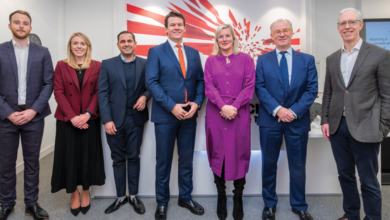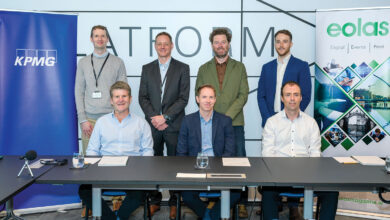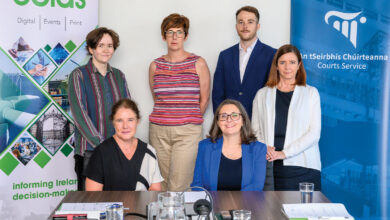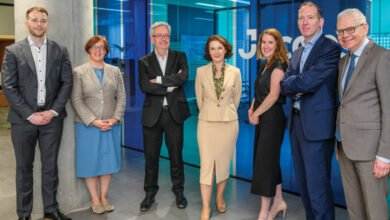Delivering Ireland’s offshore wind energy ambition

SSE Renewables hosted a virtual round table discussion with key stakeholders in the wind energy industry examining their role in delivering on the Government’s ambition for offshore wind energy.

What role will offshore wind play in reaching Ireland’s 70 per cent renewable electricity target? What steps do we need to take now to ensure we can deliver on the Government’s ambition to install 1GW by 2025 and 5GW by 2030?
Barry
Kilcline
Offshore wind effectively has to take the lead. While onshore wind will continue to make a contribution, we’re going to need to rely on offshore to take us from about 35 to 40 per cent to 70 per cent renewable electricity by 2030. The development of offshore wind is a significant opportunity for Ireland. Single large-scale projects will allow us to make leaps towards our 2030 target and will provide significant socioeconomic investment into coastal communities. If we deliver 1GW by 2025 in line with the Climate Action Plan, it will contribute 2 per cent of each year’s 7 per cent annual reduction in emissions. There are some challenges to overcome to enable offshore wind to help us reach these ambitious targets. The first one for SSE Renewables is that we are competing in a global space with Taiwan, Poland, China, the US and the UK for a very limited supply chain. We therefore need to get the industry moving quickly so that we can compete for these supply chain resources.
Garrett
Connell
Offshore is going to be crucial to both our emission reduction and renewable generation targets. It has a crucial role to play as it can generate unprecedented amounts of renewable electricity. If you look at how technology is going to improve over the next five to 10 years, turbine capacities are going to grow to between 10-15MW on a single turbine, and these can be deployed in large numbers at offshore locations where environmental and social impacts can be minimised. When you combine the ability to deploy large numbers of these turbines with the high capacity factors of between 45 and 50 per cent that you get at sea where wind resources are strongest, this is a very efficient way of producing large amounts of renewable electricity. This makes offshore wind the ideal technology to meet these targets. It will also bring high levels of investment into the country, it’s a new industry that’s starting now in Ireland.
Mark
Foley
In 20 years, Ireland has delivered 5,000MW on the all-island power system, mainly through onshore wind, alongside some solar; we’ve got to do twice that in the next 10 years. The simple proposition people need to understand is that we need all the technologies. We need more onshore wind, solar and offshore wind. That’s the message that must get out into the broad political and other spaces because there is a risk that people will latch onto one technology and think that it’s a silver bullet. Offshore will be a critical part of that equation in the coming years, it brings scale and it brings cost efficiency. I don’t doubt our engineering capabilities, the Irish developer ecosystem or the Government’s commitment to producing quality legislation, but the biggest challenge we have is winning hearts and minds and getting communities to buy into renewable technologies as being the backbone of a decarbonised power system.
Paul
Brewster
I was involved in supporting the work of the Development Task Force nearly five years ago as part of Ireland’s ocean wealth strategy, Harnessing Our Ocean Wealth. Offshore renewable energy was identified as a big growth area that could make a significant contribution to a step change in our ocean economy. The policy and supports needed for the industry have aligned. While all stakeholders had concerns about delays to foreshore licencing legislation, the industry has moved from hoping for progress to planning and the conversations are more commercially focused.
Karen
Trant
Offshore is here and, from a regulatory point of view, we must start moving in terms of frameworks and mechanisms to facilitate this and show industry that we are open for business. It’s not an all-or-nothing approach for the technologies, but in terms of scale and capacity, offshore wind can deliver on the targets. The challenge will be in public engagement and buy in for these projects.
Liam
Curran
If we look at the supply chain to deliver 5GW, we’re focused on maximising the greatest possible local content. I see the 70 per cent and 5GW targets as the beginning. If we can get a significant Irish SME contribution into those projects, it will lay the groundwork for building that industry that will subsequently go to the south, west and north west coasts and we will have floating offshore wind and hydrogen even further out. That process needs to be starting in parallel with the projects in the Irish Sea because if we get it right, the group of SMEs will be able to deliver the Irish projects and even export their capability globally.
“There are dozens of countries that are starting on the same journey as us and we need to tap into that global supply chain.”
Barry Kilcline, Director of Development, SSE Renewables
How can the policy and regulatory frameworks support offshore wind route to market? What are the key issues to be addressed in marine spatial planning?
Karen
Trant
The CRU recognises that it needs to be a bit more agile. Regulators tend to be slow and risk averse in terms of what they develop. One of the areas we have demonstrated that agility has been connection policy. We have just been through two rounds of the enduring connection policy development in relatively quick succession and what we learned from that process, through active engagement with industry, were the barriers they faced. I think that engagement was well received by the industry and, again, we’ll look at that engagement process for offshore. What will feed into that process will be the grid model, whether it’s centralised or a developer-led mixture, once that’s bedded down, we can start looking at that regulatory framework. In addition to that, there’s an offshore strategy coming from Europe, which will influence what we do. When we’re developing regulatory frameworks, we are always working in the public interest, we look at risk and decide who is best placed to bear the risk and cost, which ultimately feeds down to the consumer. We want to facilitate offshore as quickly as we can at this stage. These projects can take a long time to get up and running. When speaking to the system operators, we have emphasised the need to engage with viable, ready to go projects. Some of those projects are potentially already out there. In addition, the CRU is in the process of a revenue review process with the system operators in which the connection of offshore is very much a feature.
Garrett
Connell
If you look at the timelines for delivery for an offshore wind farm, the European experience is that it typically takes about 10 years from initial development to first power. The relevant projects have been underway for 15-20 years in some cases so we’re not beginning from a standing start. The projects that are underway are at various stages of development and will come onstream in a staggered way over the next few years. Something we need to look at to kickstart the industry is how RESS is brought forward. If we’re waiting for a large group of projects to be ready at the same time before we have a RESS auction for offshore wind, the timeline could be quite long. If we are to meet those ambitious targets, I don’t think we have that time to wait. What’s going to be important is that those early mover projects are facilitated into a RESS auction when they are ready. We may need to allow offshore projects to enter early RESS auctions rather than waiting on a large-scale offshore specific one. And of course, getting the Marine Planning and Development Management Bill enacted is the most important thing if we want to get projects through the consenting process and ready to qualify for an auction in late 2021 as planned in the Programme for Government.
Barry
Kilcline
We welcome the Government’s commitment to hold a RESS auction on an annual basis, from an onshore, offshore and solar perspective. We can all look enviously to the UK in terms of scale, but we need to remember that most of those projects are in significantly windier locations and have more scale. The more scale we can get into our projects, the more economies of scale we can drive and the better an achievement we can make in a RESS auction to pass that value onto the taxpayer. In terms of marine and spatial planning, it’s great to see progress on the MPDM Bill. It’s of significant importance to make sure we drive that MPDM Bill in as swift a fashion as we can.
“Ports operating as economic hubs is an age-old scenario and this will be no different.”
Paul Brewster, European Policy and Funding Adviser, Irish Maritime Development Office
Mark
Foley
Speed of execution should be the dominant driver in terms of considerations for 2030. In general, the MPDM Bill has to be got right and published as quickly as possible, but we also have to start dealing with vexatious planning appeals from non-interested parties. This is of vital national significance. Clear connection policy and a clear line of sight for future options are also vital. Developers need to know that there will be an auction on ‘date x’ year-upon-year if they are going to sink enormous amounts of equity into these projects. Lastly, we must have technology specific auctions with appropriate rule sets. Offshore has to have its own auction and its own rule set.
Paul
Brewster
I think there is still a gap for an overarching offshore maritime strategy here. A lot of the progress that was made with harnessing our ocean wealth has started to address and highlight some of the issues, be they regulatory or in terms of building industry. There are still a lot of gaps despite the progress. You could fight the corner about mechanisms of RESS and planning bills but when these things get delegated from the top down, they maybe happen that bit quicker. I think that’s missing in Ireland. No one has ever doubted the scale of the resources around our coast but I think we need to refocus our efforts to fully realise the potential in our maritime sectors and the wider ocean economy.
How do we ensure the development of an adequate supply chain for offshore wind in Ireland?
Liam
Curran
For Enterprise Ireland, an adequate supply chain is our priority. For the last two years, we have been working on identifying within Ireland where we have capability and relevant SMEs for the offshore wind industry. We have established an offshore wind energy cluster of 53 organisations across three groups. Firstly, there are a handful of companies who are already in the industry. The second group of companies are people on the onshore side that have capability relevant to the offshore industry. The third group are marine engineering companies who aren’t directly focused on the offshore wind industry opportunity at the moment but would certainly have the right skillsets and could turn their hand pretty readily to the offshore wind industry.
“Competition is going to be intense over the next decade in the supply chain, in terms of everything from installation vessels to booking production slots in cable and turbine manufacturing facilities.”
Garrett Connell, Project Manager of Oriel Wind Farm, Parkwind
Barry
Kilcline
The bigger concern that we have is Ireland competing at a global level. We’re hopefully going to achieve 5GW from offshore wind by 2030, but to put that in perspective, Europe is looking for 450GW by 2050. At this point in time, there are only two vessels that can put up 12MW machines and those vessels take between two and three years to build. There are dozens of countries that are starting on the same journey as us and we need to tap into that global supply chain.
Paul
Brewster
On the European targets to 2050, 80GW of the 450GW is in the Atlantic Ocean and I think it’s very interesting that the new Atlantic Action Plan has incorporated offshore renewable energy as one of its four pillars. We will share opportunities and challenges with our neighbours down the Atlantic Arc from the UK and France to Spain and Portugal. There are lots of opportunities for collaboration and the scale of what will be undertaken over the next decade is enormous. We look at where we’ve got strength and capability in this part of the world and we can build from there.
Garrett
Connell
Competition is going to be intense over the next decade in the supply chain, in terms of everything from installation vessels to booking production slots in cable and turbine manufacturing facilities. It’s very important that we indicate to the supply chain and that market that we are serious about delivering on our targets. We do that by living up to our commitments and start progressing projects to get the industry moving. It’s critical that we are seen to deliver on our targets otherwise it’s a poor message to the supply chain and the focus will drift elsewhere. Having said that, these projects are multi-billion-euro investments that need to be operated and maintained for the next 25 to 30 years. There’s a significant opportunity for long-term, high-skilled jobs into the future in rural and coastal areas, like the north-east and south-east of Ireland. Area’s that have suffered from a lack of opportunities in the past.
“The CRU recognises that it needs to be a bit more agile. Regulators tend to be slow and risk averse in terms of what they develop.”
Karen Trant, Director of Networks and Legal, Commission for Regulation of Utilities
How do we integrate offshore wind supply into the electricity grid?
Mark
Foley
I think we’re pretty clear about the job we need to do which is to strengthen the grid up the east coast of Ireland in a way that can accommodate these projects. Grid development is not easy, but we have got great clarity of purpose. EirGrid has submitted its capex requirements into the Commission for Regulation of Utilities. What we need to do now is to get on with it and work collaboratively with the developers. A story has to be told from Arklow to Dundalk that convinces the people who live on the east coast that this suite of developments is vital and in the national interest. I’d like to collaborate with developers and, indeed, the Department on telling that story so that we can avoid becoming embroiled in judicial challenges and the whole programme goes out the window.
Garrett
Connell
The East Coast Generation Opportunity Assessment that EirGrid produced last year was very good. It shows that there is capacity available at the moment on the east coast. That should be the initial focus. Let’s use that effectively and get projects underway. At the same time, and in parallel, we need to plan the reinforcement of the transmission system to enable the additional projects that are coming along. I think, initially, developer-led is the right way to go. There is a lot of experience in developing offshore and offshore connections within the European companies involved in the relevant projects. We should use that expertise while transitioning into a new regime, whatever the outcome of the Navigant report consultation might be.
Barry
Kilcline
EirGrid has done great work on system non-synchronous penetration targets, which was one of the big challenges for EirGrid over the last decade. Looking forward, if it can bring that approach to the connection and the integration of offshore wind into the electricity grid, we’ll be well placed to deal with the challenge. Sometimes we look forward without enough reflection on the achievements that Ireland Inc has made.
Karen
Trant
One of the things that the Commission for Regulation of Utilities is looking at with system operators is the stability of the system and making sure that it can facilitate that level of renewables. That’s ongoing work. In the longer-term, the hybrid models are probably something of the future. We have the potential for two interconnectors – the Greenlink and the Celtic Interconnector – so if offshore can potentially link into those, we can become an exporter rather than an importer of offshore wind energy. The capacity is there. We need to think more holistically about offshore, whether it’s meshed grids or hybrid models it’s important that in the speed to get things up and running we don’t miss potential opportunities for the longer term.
Garrett
Connell
Whatever model is brought forward for how the grid is developed, an important element to consider is the financeability of projects. These will undergo intense due diligence during their financing, so responsibilities of ownership, including operation and maintenance of offshore assets as well as guarantees on availability are all important elements which need to be considered. Let’s not rush into a model. It needs to be right or else projects will never get off the ground.
What can Ireland learn from other countries who have developed their offshore wind resources?
Mark
Foley
There are times in life when it’s good to not be first. I’ve been to Scotland to see the offshore windfarm Beatrice, which is simply staggering in terms of scale and quality of engineering. It is unquestionably world-class. The opportunity is to replicate a proven, low-cost, competitive and world-class engineering and to do so at speed. It is critical that the development community and financiers are provided with certainty and that Ireland gets on and copies what has been done in other jurisdictions, particularly the UK. The risk is much lower now because it’s proven, and the prices will be very attractive.
Liam
Curran
One lesson we can take from other jurisdictions, particularly in the UK, is the colocation of a critical mass of SMEs in the supply chain around a port. That model works really well. If you want to see that model working in a slightly different marine sector, visit Killybegs and have a look at how the pelagic fishing industry does this. There is a group of around 10 marine engineering companies there which supplies the pelagic fishing industry with a one-stop-shop of what it needs. We could take that capability and replicate it for offshore wind at a single port location on the east coast, strengthening the capabilities of the Irish SME sector, making it very attractive for developers and tier 1 contractors.
“For Enterprise Ireland, an adequate supply chain is our priority. For the last two years, we have been working on identifying within Ireland where we have capability and relevant SMEs for the offshore wind industry.”
Liam Curran, Senior Technologist, Enterprise Ireland
Paul
Brewster
Ports operating as economic hubs is an age-old scenario and this will be no different. The UK benefited enormously from its offshore oil and gas industry and as such, there were already many ports with established infrastructure alongside industry clusters which didn’t have to pivot that significantly to become involved in offshore wind. Our ports are very much focused and aware of the opportunities and indeed active in encouraging these kinds of clusters.
Garrett
Connell
Not all jurisdictions are comparable, and I think the most comparable for Ireland is the UK. If you look back to 2008, the Crown Estate, which controls the seabed in UK territorial waters, had a big ambition of 25GW which really created a line of sight on a pipeline of projects, providing great incentive to the supply chain to get involved. It also took a whole of industry approach and planned everything from allocation of sites, the consenting process, grid connections, as well as a focus on the supply chain and what the most appropriate support scheme should be. A similar cross government and industry approach is needed here to ensure that we capture as much of the opportunity as we can.
“The biggest challenge we have is winning hearts and minds and getting communities to buy into renewable technologies as being the backbone of a decarbonised power system.”
Mark Foley, Chief Executive Officer, EirGrid Group
Karen
Trant
We are already engaged with our colleagues and counterparts in Ofgem and obviously we will take all the good lessons and learnings onboard as part of our policy developments. They are currently consulting around the whole OFTO model so it will be interesting to see the outcome of that process. It’s great that the UK has so much experience in offshore wind energy and we can learn from that.
Barry
Kilcline
There are three key lessons from the UK. Firstly, the Offshore Wind Sector Deal was a very clear target to get from 8GW to 30GW by 2030 and it brought together the offshore industry in the UK. It also provided the supply chain, regulators and government confidence that targets were going to be met. The Offshore Wind Industry Council was a collaboration between key players in the UK industry and the UK Government and it allowed key decisions to be made and commitments extracted from developers in relation to, for example, the establishment of manufacturing plants. Finally, on a more operational level, the FLOWW guidelines. I know that some of the developers have been liaising with the fishing industries along the east coast, but I think an Irish version of the FLOWW guidelines would help significantly.
| Roundtable Participants |
|
Paul Brewster
|
|
Garrett Connell
Garrett Connell has been involved in the development of infrastructure projects over the past 20 years. In engineering consultancy, onshore and offshore wind development and marine renewable energy technology development. He has been involved in the Oriel offshore wind farm project in the North Irish Sea off the County Louth Coast since 2006. Is a founder member of the National Offshore Wind Association of Ireland and a long-time member of the Irish Wind Energy Association. Since the re-emergence of interest in offshore wind in Ireland in 2017, he has been leading Parkwind’s Irish office and project activities. Parkwind is a Belgian based offshore wind developer with 771MW under operational management in the Belgian North Sea and a further 1GW under active development. As one of the few companies in the industry that finances, develops and operates its offshore wind energy farms, Parkwind has managed to expand its operations internationally with rapidly growing teams based in Belgium, Ireland and North America. |
|
Liam Curran
Liam Curran is the Senior Technologist in Enterprise Ireland (EI) responsible for the Marine Sector. Working with EI colleagues in its London Office, he is helping relevant Irish SMEs with capability to engage with the UK offshore wind industry. Building Supply Chain capability in the established UK sector will ensure that Irish companies will be in prime position to be part of the supply chain for Irish Sea projects when these begin development. |
|
Mark Foley
|
|
Barry Kilcline
|
|
Karen Trant
|





